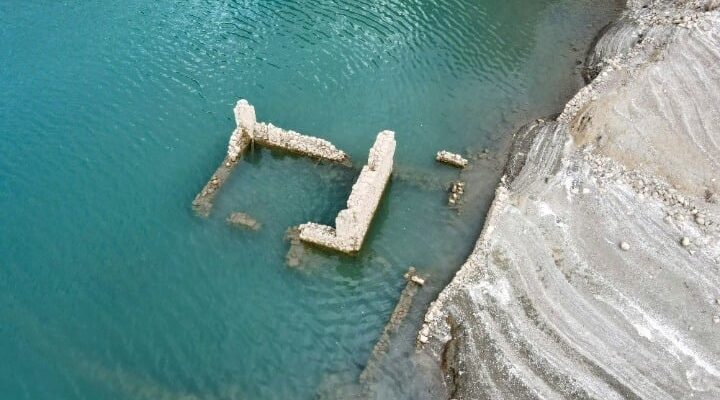
The ongoing drought in Greece has brought the village of Kallio in the Athens main reservoir back into view.
The submerged village has partly re-emerged as the drought caused the water in the artiMornos reservoir, Athens’ main water supply, to drop sharply.
The reservoir, located 200 kilometers west of the capital, has seen a 30 percent drop in its water reserves compared to last year, according to figures from EYDAP, the Attica region’s water distribution company.
Satellite images analyzed by the National Observatory of Athens show that the area of the lake covered by water—which was 16.6 sq. km. in July 2023—is currently just 12.8 sq. km.
Submerged village re-emerges
In 1980 when the artificial lake of Mornos was completed the locals were forced to move to a new settlement an altitude of 390 meters from where they observe every day that their childhood memories, their belongings, and everything they left behind gradually emerge from the waters of the lake.
The 60-odd people who stayed behind in the new settlement remember the old church of Evangelistria that has been covered by the waters and has not yet been revealed. They remember the primary school that they now see standing, their streets, alleys and cafes, the Athens Macedonia News Agency reports.
“Water levels at Mornos Lake have dropped by 40 meters,” says Yorgos Iosifidis, a retired resident who lives above the old Kallio village. Like residents, he had had to abandon his home in the late 1970s due to the construction of the Mornos Dam. Over 80 houses in Kallio, as well as the church and primary school, were “sacrificed” to supply Athens with water.
“If you zoom in with your camera, you will see the ground floor of my father-in-law’s two-storey house (…) and next to it, the remnants of my cousins’ house,” Iosifidis said.

Kallio has reappeared for the second time. The previous occasion was during a drought in the early 1990s, recalls Iosifidis. “If it doesn’t rain soon, the current level will continue to fall and the problem will be more serious than before,” he fears.
Drought in Greece
Facing the risk of water scarcity, Greek authorities have asked the 3.7 million inhabitants of the Attica region, the area encircling Athens and home to a third of the Greek population, to closely monitor their water consumption. No restrictions have been imposed, but there are daily appeals for moderation in the media and on social networks.
To strengthen the water supply, EYDAP decided to activate additional sources near the capital.
Several parts of Greece, and in particular the islands of the Aegean, are bracing for drought as rainfall has been halved over the last decade and water reserves are being depleted, scientists warn.
Rainfall in many areas of Greece has decreased by up to a staggering 50 percent in previous months compared to the average of the last decade, according to research by the National Observatory of Athens network and the Meteo.gr team.
The research found a significant drop in total rainfall in most areas from October 2023 to April 2024, the period when most rainfall occurs in Greece. The only exceptions to the trend are parts of Epirus and Western Macedonia. The comparison was made with the average of the corresponding seven-month period of the decade 2012-2022.
Earlier this summer, a study conducted by the National Observatory of Athens and published in the scientific journal Atmospheric Research revealed shocking details about the water shortage problem in various areas of Greece.
Fourteen Greek municipalities have been placed under a state of emergency by the General Secretariat of Civil Protection. Among these are five municipalities on the island of Crete, as well as on Serifos, Sifnos, Leros, Poros, and Spetses. Moreover, the municipality of Sami on Kefalonia has also been affected, as have areas in Corinth, Alexandroupolis, and Xanthi.



